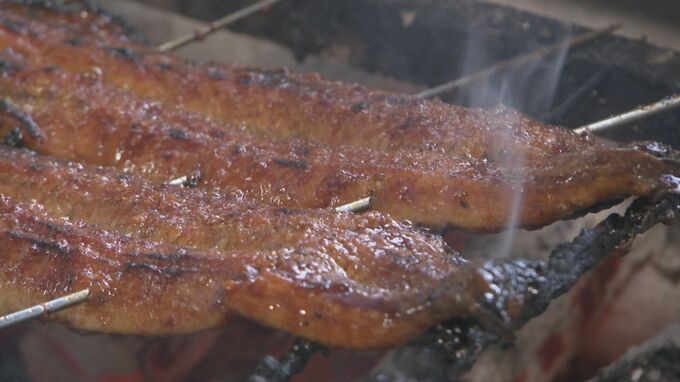The European Union has proposed adding Japanese eel and other species to the list of protected wildlife under CITES (the Convention on International Trade in Endangered Species).
Amid this development, we visited a renowned eel restaurant in Nagoya…
“We’re now in Higashi Ward, Nagoya. With ‘Doyo no Ushi no Hi’ (the traditional eel-eating day) approaching, today we’re visiting a famous eel restaurant.”
We visited “Unagi no Nishimoto,” a 95-year-old establishment.
“The outer skin is delightfully crispy and aromatic, while the inner flesh remains fluffy and tender.”
Their signature “hitsumabushi” dish can also be enjoyed with a special blended sauce made from bonito and flying fish stock. On busy days, they serve about 100 portions of this popular menu item.
Q: How was the eel in reality?
“Delicious. Hearty. Amazing. Absolutely delicious.”
“Eating eel gives me energy to keep going tomorrow. Even if prices rise somewhat, I’ll still make the effort – that’s how strongly I feel about it.”
Japanese eel
Japanese eel (*unagi*) is a culturally and culinarily significant dish in Japan, traditionally grilled and glazed with a sweet soy-based sauce (*kabayaki*). Historically, eel has been consumed since the Edo period (1603–1868), believed to provide stamina in hot summers, leading to the custom of eating it on *Doyo no Ushi no Hi* (Midsummer Day of the Ox). Due to overfishing and habitat loss, Japanese eel is now endangered, prompting conservation efforts and sustainable farming practices.
CITES
CITES (the Convention on International Trade in Endangered Species of Wild Fauna and Flora) is an international agreement established in 1973 to regulate and protect endangered species from over-exploitation through trade. It aims to ensure that international trade does not threaten the survival of wild animals and plants, with over 38,000 species currently listed under its protection. CITES operates through a system of permits and regulations, involving 184 member countries working together to promote conservation.
Doyo no Ushi no Hi
“Doyo no Ushi no Hi” (土用の丑の日) is a traditional Japanese event occurring during the *Doyo* period (the hottest 18 days of summer according to the lunar calendar). Historically tied to the Chinese zodiac, it centers on eating eel (*unagi*) for stamina in the heat, a custom popularized in the Edo period (1603–1868) by scholar Hiraga Gennai to boost eel sales. Today, it remains a beloved summer tradition in Japan.
Unagi no Nishimoto
“Unagi no Nishimoto” is a renowned Japanese eel restaurant, famous for its traditional *unagi* (freshwater eel) dishes, particularly *unadon* (grilled eel over rice). Established in the early 20th century, it has preserved time-honored cooking methods, such as grilling eel over charcoal and using a secret sauce recipe passed down through generations. Located in a historic area, it reflects Japan’s long-standing culinary appreciation for eel, dating back to the Edo period.
hitsumabushi
Hitsumabushi is a traditional Japanese dish from Nagoya, consisting of grilled eel (unagi) served over rice and typically eaten in three stages: plain, with condiments, and as a tea-soaked dish. It originated in the late 19th or early 20th century, evolving from the popular unagi dishes of the Edo period. The method reflects Nagoya’s culinary creativity and emphasizes savoring the eel in multiple ways.






